| « Bon Appetit at The Spice House | Pump(kin) Up the Economy, Yo » |
Recipe Sun Oct 19 2008
South Indian Sambar in Chicago
No sooner than I was off a plane from India, I wanted my kitchen smelling like her food. A certain chowdery, gravy-like or soupy vegetable mix came with many of my meals in India. I thought this dish, sambar, would be iconic enough a starting point to get serious about Indian cooking at home in Chicago. I emailed a friend from the South Indian city of Mangalore for help. She came through with wonderful step-by-step photos and detailed written instructions.
 |  |
Think of the recipe in three key parts: cook chopped vegetables, cook toor dal (split yellow pigeon peas), and make a masala (a mixture of spices). The following sambar is the popular type in and around Mangalore. The masala involves grinding coconut into a mix of fried spices. The vegetable can be of any type, but the commonly kinds, as my friend wrote, are potato with onion, drumstick, lady finger (okra), tomato, pumpkin, brinjal (eggplant), ash gourd, and Mangalore cucumber." The preparation may vary a bit as need to accommodate different vegetables. I thought it'd be fun to substitute farmers’ market sunchokes (Jerusalem artichokes) for potatoes. Their smooth, earthy and starchy flavor might add a nice depth. Similarly, I made three leeks stand in place of the onions. The leeks have a smooth and gentle flavor to their sharper onion relative.
Ingredient List from Mangalore, India:
Vegetables
5 medium potatoes
6 small onions
1 green chilly
2 tsp salt crystals (or perhaps up to 3 tsp using powdered salt, but try a smaller amount first to check against your own preference)
2-inch diameter ball of jaggery
1 tsp chilly powder (optional)
Liquid from a 1-inch diameter ball of tamarind soaked in water 5 minutes, and then squeezed, tamarind removed (I used some 1/4 tsp of tamarind concentrate mixed with water)
750 ml water (about 3/4 quart)
Dal
1/2 bowl toor dal (see photo)
250 ml water
1 pinch turmeric
Masala
6 red chilies
1 tsp cumin seeds
1 tsp black gram dal (hulled and therefore white in color)
1/4 tsp fenugreek (seeds)
[correction] 2 tsp coriander seeds
1/2 bowl coconut gratings (see photo)
Garnish
4 twigs of curry leaves
1 tsp (black) mustard seeds
Black gram dal (hulled and therefore white in color)
Overall
Cooking oil (my South Indian friend used coconut oil, I used olive oil)
Step 1 - Prep: My friend instructed me to peel potatoes and cut them into small 2-inch pieces. Then, cut the onions and green chili length-wise. I deviated just a bit. I used sunchokes instead of potatoes, didn't peel them, but still cut them into 2-inch pieces. I sliced leeks down the middle twice to quarter the long stalks, then across and into pieces. I momentarily veered from the recipe, and the green chilies were chopped into pieces, instead of down the middle, and used in the masala instead.
 | 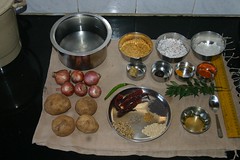 |
Step 2 - Boiling: I brought the sunchokes to a boil, just as my South Indian friend suggested I cook the potatoes, in a large and covered pot of water. When it begins to boil, open the cover just a bit to prevent a messy spillover, reduce the heat to medium, and keep the sunchokes (or potatoes) boiling until they're tender.
Step 3 - Dal: While the sunchokes (or potatoes) are boiling, add the toor dal to a pot with about an equal amount of water. Add a pinch of powdered turmeric and a drop of oil, cover the pot, and bring it to a boil. After a few minutes, when the dal begins to boil, open the lid up a bit to let the pressure out. In about 10 to 13 minutes, the dal will have cooked and thickened. Reduce the heat and, if the water all dries up, add a few more spoonfuls to keep the dal from burning. Cook until the dal is "soft, thick, with little water left behind," as my friend wrote.
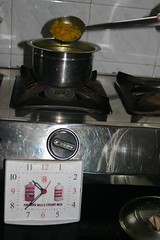 |
|
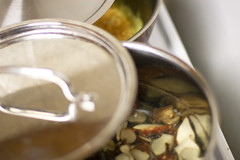 | 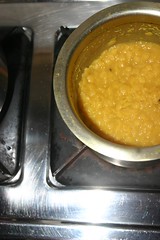 Completely cooked toor dal in Mangalore |
Step 4 - Masala: Heat 2 tsp of oil in a sauté pan (in Indian, you'd use a Kauai). Add red chilies (I used green instead, as the peppers currently growing on my cayenne plant hadn't turned from green to red yet), [correction] coriander seeds, cumin seeds, black gram dal (I only had unhulled black gram dal, and since it was to be ground, I used it anyway, as the rough outer layer would be finely ground), and fenugreek seeds. Fry only 2 to 3 minutes, stirring continuously to prevent burning, and remove the pan from the heat as soon as you smell the fragrance. Cool this fried masala, and then blend with grated coconut and about 50 ml of water into a smooth paste the consistency of a chutney. You can also use sambar powder instead of sautéing the individual spices on the stove, but you may want to fry the powder in a little oil on low for a minute to bring out the aroma, or as my friend aptly puts it, to give "a fresh smell to the masala." Then, grind the powder with the coconut flakes and water.
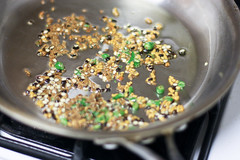 |
 |
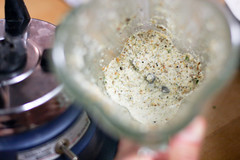 |
 |
 |
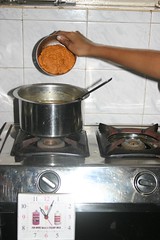 |
Step 5 - Combine: The potatoes (or sunchokes) are done cooking when a knife effortlessly passes through. Add the onions (or leeks in this case) and green chili (in this case, I skipped the chili here because I had already added it to the masala). Cook 5 minutes. Then add the cooked dal, and mix well. After 1 to 2 minutes, add salt, jaggery (you may substitute this unrefined sugar with conventional sugar), chili powder and tamarind juice, and stir and cook for 2 minutes. Next, add the ground masala, check the consistency, and if too thick add a little water. Simmer 3 to 4 minutes and you have your sambar.
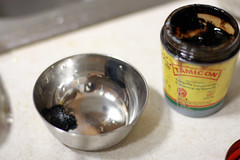 |
 |
 |
 |
Step 6 - Garnish: In a sauté pan with 1/2 tsp of hot oil, fry the mustard seeds and black gram (I skipped the black gram time because I had only unshelled and we weren't going to grind this). When the seeds start popping out of the pan, add the curry leaves (I used dried, but fresh would be best) and cook for just 10 more seconds. Add this garnish to the sambar you combined in step 5.
Post-Trial Notes: This was my fourth try at sambar. It wasn't as creamy as I would have liked it. Perhaps I could have measured or used less water for the potatoes. The most obvious culprit however, judging from my photos against the photos from Mangalore, is that I didn't have as much of the smooth masala that thickens the dal. My friend Jessica had helped me through this trial (and my first one) and we sat down to eat this sambar with Brussels sprouts, cut fresh from the stalk and sautéed in olive oil with red onions, salt, black pepper and a touch of balsamic vinegar. Spigariello (a leafy version of broccoli) went in at the end, cooked until slightly wilted. Brussels sprouts aren't a typical pairing to sambar, as far as I know, but they are something I know how to make reasonably well, which balanced out an evening of trying a new recipe, and increased the chance that something would turn out quite well. The next day, leftover sambar went well over brown basmati rice.
Photos on left: by Chris Brunn and taken in Chicago.
Photos on right: courtesy of my South Indian friend, Vidya, in Mangalore.






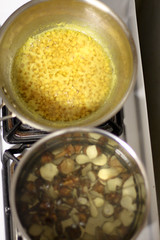



Illinois Master Gardener / October 20, 2008 12:00 PM
People from India are so well disciplined. This recipe illustrates that they even put a lot of time and expertise into their cooking!